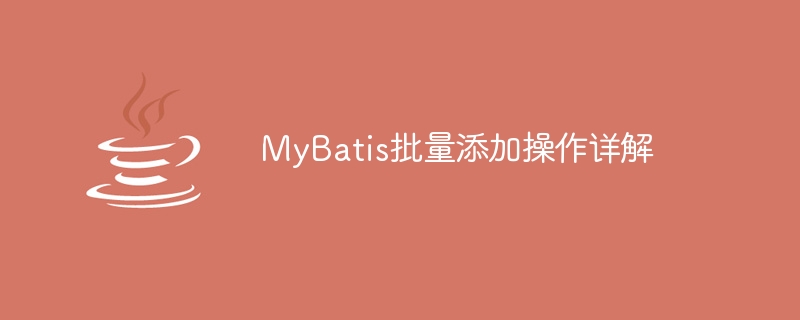
MyBatis是一款流行的Java持久层框架,在数据库操作中有着很好的灵活性和扩展性。在实际开发中,我们经常会遇到批量添加数据的需求,本文将详细介绍如何在MyBatis中进行批量添加操作,并提供具体的代码示例。
批量添加操作指的是一次性向数据库中插入多条数据的操作。相比单条插入,批量添加能够有效减少与数据库的交互次数,提高数据插入的效率。
在MyBatis中,实现批量添加数据的方式有多种,其中比较常用的是使用foreach标签结合insert语句来批量插入数据。下面将以一个具体的示例来详细说明这个操作步骤。
假设我们有一个学生实体类Student,包括学生的姓名和年龄字段。我们需要向数据库中批量添加多个学生的信息。
首先,定义对应的实体类Student:
public class Student {
private Long id;
private String name;
private Integer age;
// 省略getter和setter方法
}然后,编写MyBatis的Mapper XML文件 StudentMapper.xml,并在其中定义批量添加学生数据的SQL语句:
<!-- StudentMapper.xml -->
<mapper namespace="com.example.mapper.StudentMapper">
<insert id="batchInsert" parameterType="java.util.List">
INSERT INTO student (name, age)
VALUES
<foreach collection="list" item="item" separator="," >
(#{item.name}, #{item.age})
</foreach>
</insert>
</mapper>在上面的示例中,我们使用了foreach标签对传入的学生列表进行遍历,生成对应的插入值。
接着,在对应的Mapper接口StudentMapper中定义批量插入数据的方法:
public interface StudentMapper {
void batchInsert(List<Student> students);
}最后,在Service层或者其他业务逻辑层调用batchInsert方法,传入学生列表即可实现批量插入操作。
@Service
public class StudentService {
@Autowired
private StudentMapper studentMapper;
public void batchInsertStudents(List<Student> students) {
studentMapper.batchInsert(students);
}
}通过上述示例,我们详细介绍了在MyBatis中实现批量添加数据的操作步骤,并提供了具体的代码示例。批量添加操作能够显著提高数据插入的效率,对于需要频繁插入大量数据的场景尤为重要。希望本文能够帮助到对MyBatis批量添加操作感兴趣的开发者们。
以上就是深入解析MyBatis的批量插入操作的详细内容,更多请关注php中文网其它相关文章!

每个人都需要一台速度更快、更稳定的 PC。随着时间的推移,垃圾文件、旧注册表数据和不必要的后台进程会占用资源并降低性能。幸运的是,许多工具可以让 Windows 保持平稳运行。

Copyright 2014-2025 https://www.php.cn/ All Rights Reserved | php.cn | 湘ICP备2023035733号